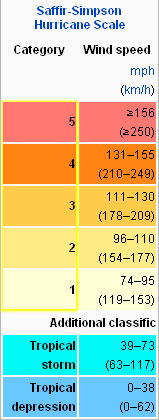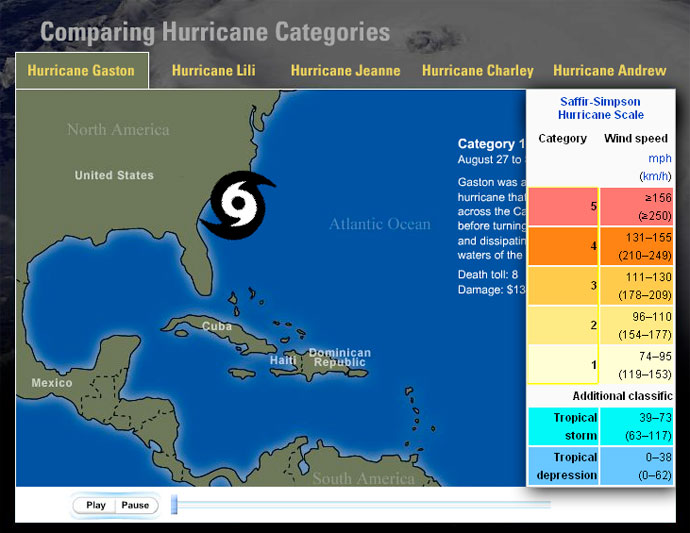Comparing Hurricane Categories
Click on the image below to see the path of an Atlantic hurricane from each category of the Saffir-Simpson Hurricane Scale. Color-coded squares show the hurricane's intensity. Learn more about the different categories of hurricane in the descriptions below.

Category 5: A Catastrophic Hurricane
Winds: greater than 155 mph, 135 kts, 249 km/h
Minimum surface pressure: lower than 920 mbar
Storm surge: higher than 18 ft, 5.6m
Shrubs and trees blown down; considerable damage to roofs of buildings; all signs down. Very severe and extensive damage to windows and doors. Complete failure of roofs on many reisdences and industrial buildings. Extensive shattering of glass in windows and doors. Some complete building failures. Small buildings overturned or blown away. Complete destruction of all structures less than 15 feet above sea level within 500 yards of shore. Low-lying escape routes inland cut by rising water 3 to 5 hours before hurricane center arrives. Massive evacuation of residential areas on low ground within 5 to 10 miles of shore possibly required. Example: Hurricane Camille (1969).
Category 4: An Extreme Hurricane
Winds: 131-155 mph, 114-135 kts, 210-249 km/h
Minimum surface pressure: 944-920 mbar
Storm surge: 13-18 ft, 3.9-5.6 m
Shrubs and trees blown down; all signs down. Extensive damage to roofing materials, windows, and doors. Complete failure of roofs on many small residences. Complete destruction of mobile homes. Flat terrain 10 feet or less above sea level flooded inland as far as 6 miles. Major damage to lower floors of structures near shore due to flooding and battering by waves and floating debris. Low-lying escape roues inland cut by rising water 3 to 5 hours before hurricane center arrives. Major erosion of beaches. Massive evacuation of all residences within 500 yards of shore possibly required, and of single story residences within 2 miles of shore. Example: Hurricane Charley (2004).
Category 3: An Extensive Hurricane
Winds: 111-130 mph, 97-113 kts, 178-209 km/h
Minimum surface pressure: 964-945 mbar
Storm surge: 9-12 ft, 2.7-3.8 m
Foliage torn from trees; large trees blown down. Practically all poorly constructed signs blown down. Some damage to roofing materials of buildings; some wind and door damage. Some structural damage to small buildings. Mobile homes destroyed. Serious flooding at coast and many smaller structures near coast destroyed; larger structures near coast damaged by battering waves and floating debris. Low-lying escape routes inland cut by rising water 3 to 5 hours before hurricane center arrives. Flat terrain 5 feet or less above sea level flooded inland 8 miles or more. Evacuation of lowlying residences within several blocks of shoreline possibly required. Example: Hurricane Gloria (1985).
Category 2: A Moderate Hurricane
Winds: 96-110 mph, 84-96 kts, 154-177 km/h
Minimum surface pressure: 979-965 mbar
Storm surge: 6-8 ft, 1.8-2.6 m
Considerable damage to shrubbery and tree foliage; some trees blown down. Major damage to exposed mobile homes. Extensive damage to poorly constructed signs. Some damage to roofing materials of buildings; some window and door damage. No major damage to buildings. Coast roads and low-lying escape routes inland cut by rising water 2 to 4 hours before arrival of hurricane center. Considerable damage to piers. Marinas flooded. Small craft in unprotected anchorages torn from moorings. Evacutation of some shoreline residences and low-lying areas required. Example: Hurricane Bob (1991).
Category 1: A Minimal Hurricane
Winds: 74-95 mph, 64-83 kts, 119-153 km/h
Minimum surface pressure: higher than 980 mbar
Storm surge: 3-5 ft, 1.0-1.7 m
Damage primarily to shrubbery, trees, foliage, and unanchored homes. No real damage to other structures. Some damage to poorly constructed signs. Low-lying coastal roads inundated, minor pier damage, some small craft in exposed anchorage torn from moorings. Example: Hurricane Jerry (1989).
Related Links
Multimedia Discovery Missions: Lesson 14 - Hurricanes


